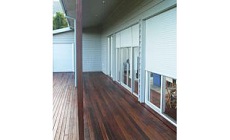

About
We Are a family run Business that aim to help people in the purchase of Building products . With over 40 years expereince in the building supply industry we aim to do our best in helping people find the right product or at least point them in the right direction to companys that can help.
Brochures and links
White Mahogany
Botanical name
Eucalyptus acmenoides
Eucalyptus tenuipes
Eucalyptus umbra
Origin
White Mahogany grows on the east coast from Sydney to Atherton in Queensland.
Trading names White Mahogany
Appearance
Heartwood : yellow-brown.
Sapwood : usually sufficiently paler to be distinguishable.
Texture : medium and even.<
Grain: usually interlocked.
Growth rings : not easily distinguished.
Scribbly borer markings : occasional.
Closely resembles tallowwood but is of a less greasy nature.
General comment
Slow to dry but little degrade or collapse.
Common uses
Heavy engineering, marine structures, boat building, poles, piles, sleepers, general construction, panelling, cladding, flooring (usually in a mixed species floor) and decking.
Properties
(See notes below)
Hardness rating:Average Hardness Rating - Dry: Very Hard
Lyctid Susceptibility of Sapwood : Not susceptible(source AS 5604)
Termite Resistance of Heartwood (inside above ground): Resistant(source AS 5604)
Marine Borer Resistance of Heartwood:Class 2(source AS 5604)
Natural Durability Rating of Heartwood Above Ground : Class 1 (source AS 5604)
Natural Durability Rating of Heartwood In-Ground Contact : Class 1(source AS 5604)
Notes
Density: 'Green Density' (GD) is the density of the wood at the time the living tree is felled. It varies considerably with the season, weather conditions, the age of the tree and so on; the quoted figure must therefore be accepted as a guideline only and when accurate green density figures are required for, say, assessment of transport costs, it is advisable to carry out accurate determinations on the materials involved.
'Dry Density' or 'Air Dry Density' (ADD) is the average density of the wood at 12 per cent moisture content. It too varies with conditions of growth, climate and maturity of wood.
There are published figures for both Green Density and Air Dry Density of most commercial species.
The figures given above have been rounded to the nearest 50.
Hardness rating: the hardness rating of a timber species is measured by the Janka Test. This is a standard test which measures the penetration into the timber of a common load and projectile. The results relate to a hardness capacity of the material and are expressed in kN. This information is useful where the timber may be subject to potential damage from impacts e.g. a dance floor. There are 2 sets of published figures; one for 'Green' or freshly felled timber and one for seasoned timber - i.e. timber with a moisture content of 12%.
The ratings given here are:
Soft - less than 5.5
Moderate - 5.5 to 7.0
Hard - 7.1 to 10.0
Very Hard - greater than 10.0.
Lyctid susceptible sapwood: Only the sapwood of some hardwoods is susceptible to lyctid borer attack. No softwoods are susceptible to attack.
Natural durability ratings: The natural durability rating of a timber species is a rating of the timber's resistance to attack by wood destroying fungi and wood destroying insects. The sapwood of all timber species has poor resistance and so the natural durability rating applies only to the heartwood of a timber species. The rating is based on the testing of stakes and poles embedded in the ground and on expert opinion of historical performance. There are 2 sets of ratings: one for above ground use and one for in-ground contact use. The lower the number the higher the performance in terms of durability. This information is useful for specifying material for external or exposed applications.

Gallery







